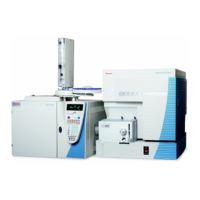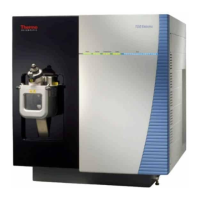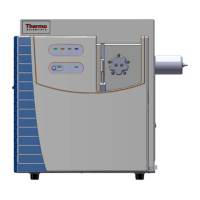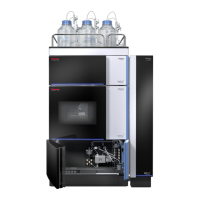Thermo Scientific TSQ Endura and TSQ Quantiva Hardware Manual 87
Glossary
A
API ion transfer tube A tube assembly that assists in
desolvating ions that are produced by the ESI, APCI,
or NSI nozzle.
API ion transfer tube offset voltage A DC voltage
applied to the ion transfer tube. The voltage is
positive for positive ions and negative for negative
ions.
API source The sample interface between the liquid
chromatograph (LC) and the mass spectrometer
(MS).
API stack Consists of the components of the API
source that are held under vacuum and includes the
ion spray cone, ion transfer tube, exit lens, and ion
transfer tube mount.
atmospheric pressure chemical ionization (APCI) A
soft ionization technique done in an ion source
operating at atmospheric pressure. Electrons from a
corona discharge initiate the process by ionizing the
mobile phase vapor molecules. A reagent gas forms,
which efficiently produces positive and negative ions
of the analyte through a complex series of chemical
reactions.
atmospheric pressure ionization (API) Ionization
performed at atmospheric pressure by using
atmospheric pressure chemical ionization (APCI),
heated-electrospray (H-ESI), or nanospray ionization
(NSI).
atmospheric pressure photoionization (APPI) A
soft ionization technique that shows an ion generated
from a molecule when it interacts with a photon
from a light source.
auxiliary gas The outer-coaxial gas (nitrogen) that
assists the sheath (inner-coaxial) gas in dispersing
and/or evaporating sample solution as the sample
solution exits the ESI or APCI (optional) spray
insert.
C
centroid data Data used to represent mass spectral
peaks in terms of two parameters: the centroid (the
weighted center of mass) and the intensity. The data
is displayed as a bar graph. The normalized area of
the peak provides the mass intensity data.
charge state The imbalance between the number of
protons (in the nuclei of the atoms) and the number
of electrons that a molecular species (or adduct ion)
possesses. If the species possesses more protons than
electrons, its charge state is positive. If it possesses
more electrons than protons, its charge state is
negative.
collision energy The energy used when ions collide
with the collision gas.
collision gas A neutral gas used to undergo collisions
with ions.
A B C D E F G H I J K L M N O P Q R S T U V W X Y Z

